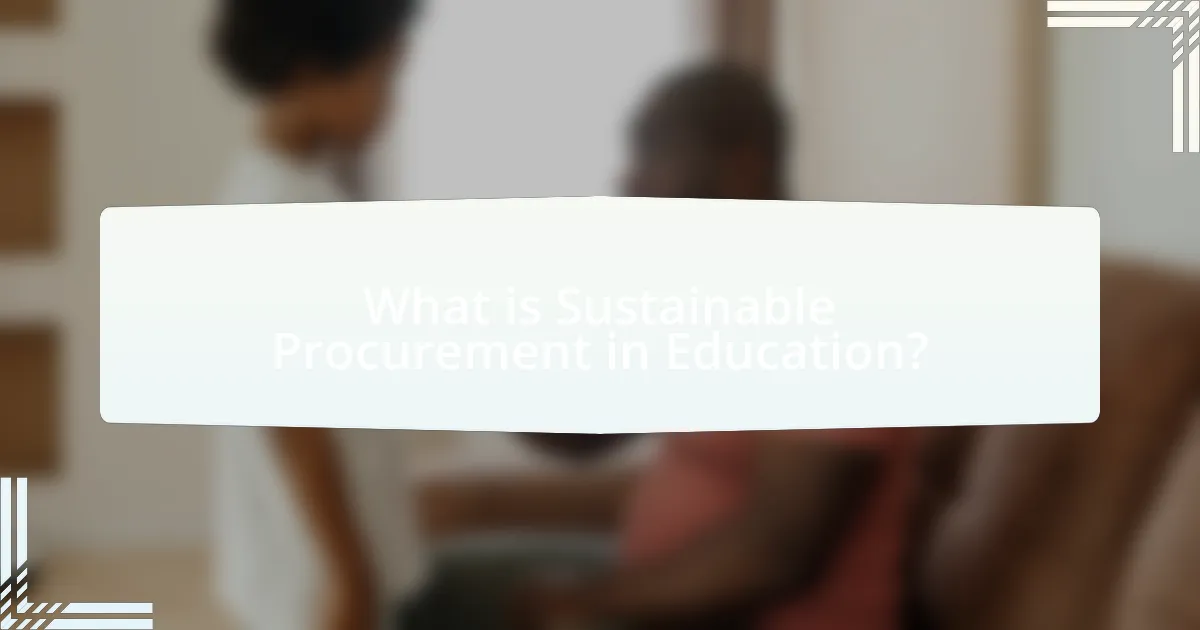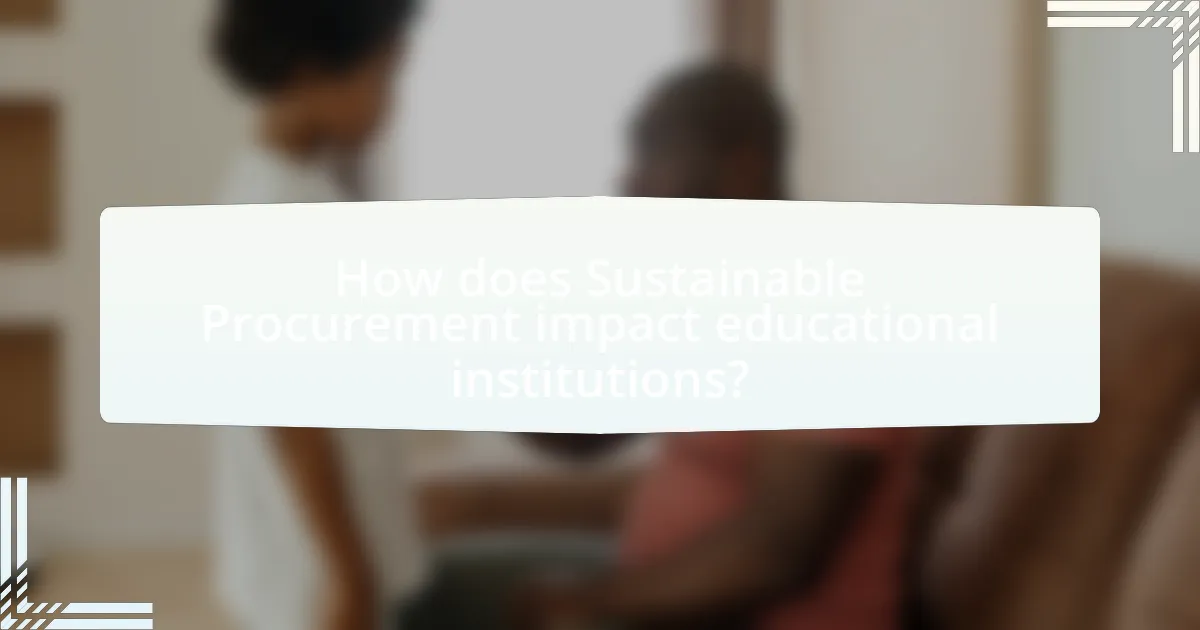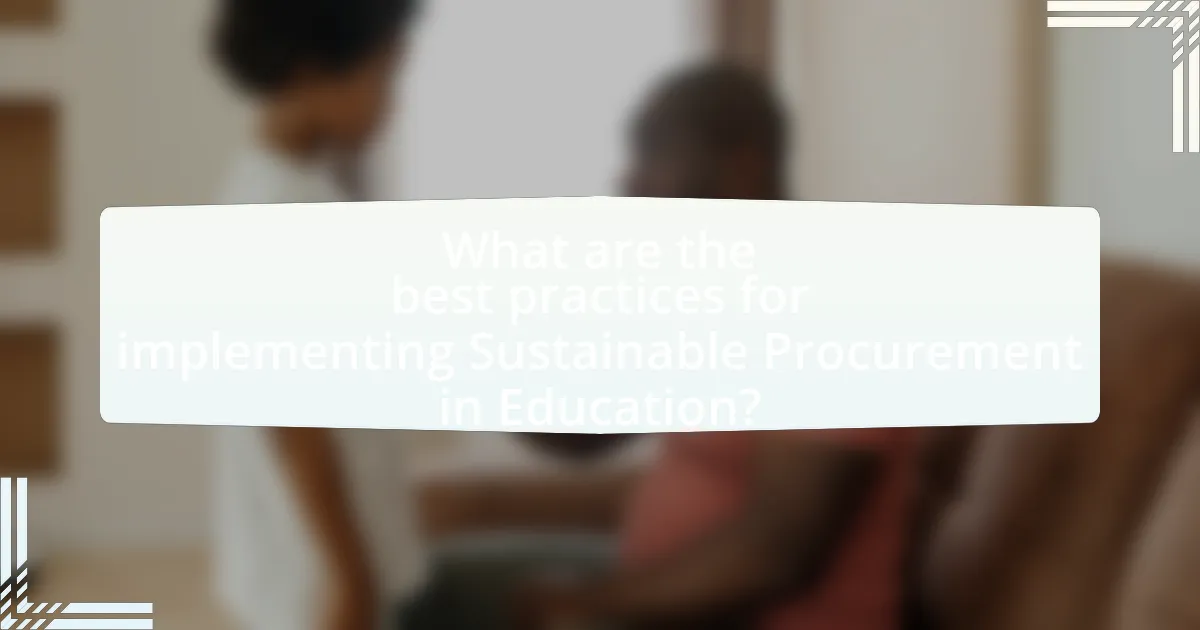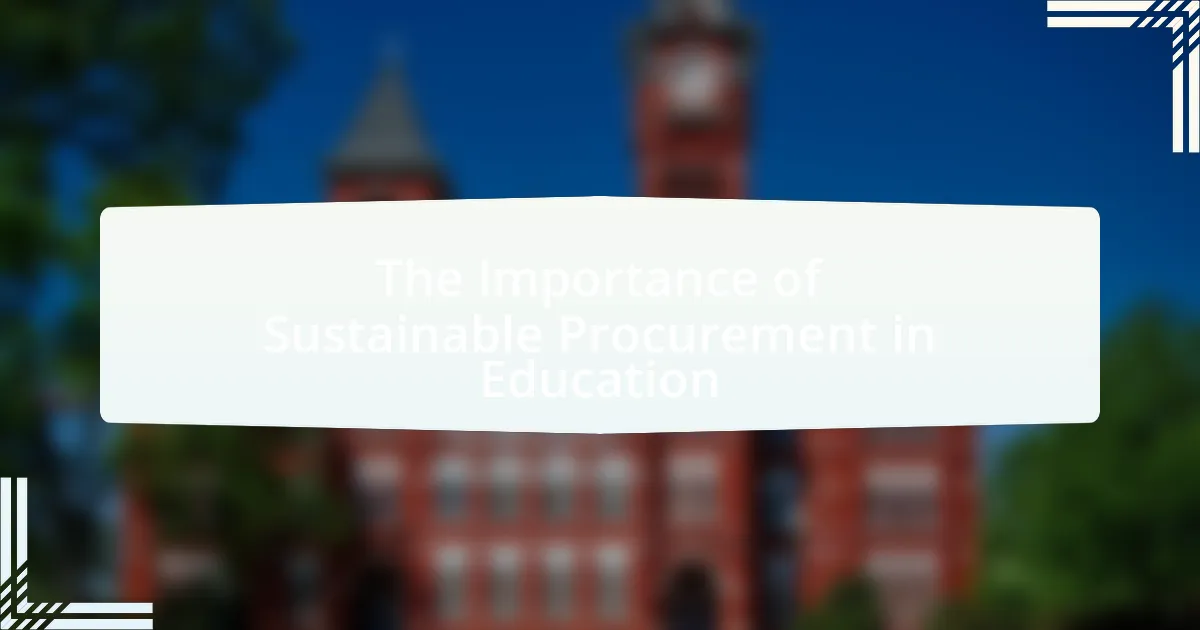Sustainable procurement in education is the practice of acquiring goods and services while considering their environmental, social, and economic impacts. This approach aims to minimize negative environmental effects, promote social equity, and enhance economic viability, ultimately benefiting educational institutions and their communities. Key principles include environmental responsibility, social equity, and economic viability, which differentiate sustainable procurement from traditional methods focused solely on cost and efficiency. The article explores the importance of sustainable procurement in education, its goals, benefits, challenges, and best practices, emphasizing its role in fostering environmental stewardship and social responsibility while achieving cost savings and improved community relations.

What is Sustainable Procurement in Education?
Sustainable procurement in education refers to the process of acquiring goods and services in a manner that considers environmental, social, and economic impacts. This approach aims to minimize negative effects on the environment while promoting social equity and economic viability. For instance, educational institutions may prioritize purchasing products made from recycled materials or sourced from local suppliers to reduce carbon footprints and support community economies. Research indicates that sustainable procurement can lead to cost savings and improved resource efficiency, as highlighted in the “Sustainable Procurement in Education” report by the United Nations Environment Programme, which emphasizes the long-term benefits of integrating sustainability into procurement practices.
Why is Sustainable Procurement important in the educational sector?
Sustainable procurement is important in the educational sector because it promotes environmental stewardship, social responsibility, and economic efficiency. By prioritizing sustainable products and services, educational institutions can reduce their carbon footprint, support local economies, and foster ethical labor practices. For instance, a study by the University of Cambridge found that sustainable procurement can lead to a 20% reduction in greenhouse gas emissions in educational facilities. This approach not only enhances the learning environment but also sets a positive example for students, teaching them the value of sustainability and responsible consumption.
What are the key principles of sustainable procurement?
The key principles of sustainable procurement include environmental responsibility, social equity, and economic viability. Environmental responsibility focuses on minimizing negative impacts on the environment by selecting products and services that are eco-friendly and sustainable. Social equity emphasizes fair labor practices and community engagement, ensuring that procurement processes benefit all stakeholders. Economic viability ensures that sustainable choices are also cost-effective, promoting long-term financial sustainability. These principles are essential for integrating sustainability into procurement practices, particularly in educational institutions, where responsible resource management can significantly influence community well-being and environmental stewardship.
How does sustainable procurement differ from traditional procurement?
Sustainable procurement differs from traditional procurement primarily in its focus on environmental, social, and economic impacts throughout the supply chain. While traditional procurement emphasizes cost and efficiency, sustainable procurement incorporates criteria such as ethical sourcing, resource conservation, and supplier diversity. For instance, a study by the United Nations Environment Programme highlights that sustainable procurement practices can lead to reduced carbon footprints and improved community welfare, demonstrating the tangible benefits of integrating sustainability into purchasing decisions.
What are the goals of implementing sustainable procurement in education?
The goals of implementing sustainable procurement in education include reducing environmental impact, promoting social responsibility, and enhancing economic efficiency. By prioritizing eco-friendly products and services, educational institutions aim to minimize waste and carbon emissions, contributing to a healthier planet. Additionally, sustainable procurement fosters social equity by supporting local suppliers and fair labor practices, thereby benefiting communities. Economic efficiency is achieved through cost savings over time, as sustainable products often lead to lower operational costs. These goals align with global sustainability initiatives, such as the United Nations Sustainable Development Goals, which emphasize responsible consumption and production.
How does sustainable procurement contribute to environmental sustainability?
Sustainable procurement contributes to environmental sustainability by prioritizing the purchase of goods and services that minimize negative environmental impacts. This approach encourages the selection of products made from renewable resources, reduces waste through recycling and reuse, and supports suppliers who adhere to environmentally friendly practices. For instance, a study by the United Nations Environment Programme highlights that sustainable procurement can lead to a reduction in greenhouse gas emissions by promoting energy-efficient products and services. By integrating sustainability criteria into procurement processes, organizations can significantly lower their ecological footprint while fostering a market for sustainable goods.
What role does sustainable procurement play in social responsibility?
Sustainable procurement plays a crucial role in social responsibility by ensuring that purchasing decisions consider environmental, social, and economic impacts. This approach promotes ethical sourcing, supports local communities, and encourages fair labor practices. For instance, organizations that adopt sustainable procurement practices often prioritize suppliers who demonstrate commitment to social equity and environmental stewardship, thereby fostering a more responsible supply chain. Research indicates that companies engaging in sustainable procurement can enhance their reputation and stakeholder trust, as they align their operations with broader societal values and contribute to sustainable development goals.

How does Sustainable Procurement impact educational institutions?
Sustainable procurement significantly impacts educational institutions by promoting environmentally responsible purchasing practices that reduce waste and enhance resource efficiency. By integrating sustainability into their procurement processes, educational institutions can lower their carbon footprint, support local economies, and foster social equity. For instance, a study by the University of Cambridge found that sustainable procurement practices in educational settings can lead to a 20% reduction in greenhouse gas emissions associated with supply chains. This not only contributes to environmental goals but also sets a positive example for students, teaching them the importance of sustainability in their future careers.
What benefits do educational institutions gain from sustainable procurement?
Educational institutions gain several benefits from sustainable procurement, including cost savings, enhanced reputation, and improved environmental impact. By adopting sustainable procurement practices, these institutions can reduce operational costs through energy-efficient products and waste reduction strategies. For instance, a study by the University of California found that sustainable purchasing led to a 20% reduction in energy costs over five years. Additionally, engaging in sustainable procurement enhances the institution’s reputation among students and stakeholders, as it demonstrates a commitment to social responsibility and environmental stewardship. This positive perception can attract prospective students and faculty who prioritize sustainability. Furthermore, sustainable procurement contributes to a reduced carbon footprint, aligning educational institutions with global sustainability goals and fostering a culture of environmental awareness within the community.
How can sustainable procurement lead to cost savings for schools?
Sustainable procurement can lead to cost savings for schools by reducing long-term operational expenses through efficient resource management and waste reduction. By prioritizing environmentally friendly products and services, schools can lower energy and water consumption, which directly decreases utility bills. For instance, a study by the National Association of State Procurement Officials found that schools implementing sustainable practices reported savings of up to 30% on energy costs. Additionally, sustainable procurement often involves purchasing durable goods that require less frequent replacement, further contributing to cost efficiency.
What improvements in community relations can arise from sustainable procurement?
Sustainable procurement can significantly enhance community relations by fostering trust and collaboration between educational institutions and local stakeholders. When schools and universities prioritize sustainable sourcing, they often engage with local suppliers and businesses, which strengthens economic ties and supports the community’s growth. For instance, a study by the National Association of State Procurement Officials found that local procurement can lead to a 20% increase in community investment, demonstrating a direct correlation between sustainable practices and improved local relationships. Additionally, sustainable procurement initiatives often involve community input, ensuring that the needs and values of local residents are considered, which further builds rapport and mutual respect.
What challenges do educational institutions face in adopting sustainable procurement?
Educational institutions face several challenges in adopting sustainable procurement, primarily including budget constraints, lack of awareness, and insufficient training. Budget constraints limit the ability to invest in sustainable products, as these often come with higher upfront costs despite potential long-term savings. Lack of awareness among staff and decision-makers about the benefits and practices of sustainable procurement hinders effective implementation. Additionally, insufficient training on sustainable procurement practices prevents staff from making informed purchasing decisions. These challenges collectively impede the transition to more sustainable procurement practices within educational institutions.
What are the common barriers to implementing sustainable procurement practices?
Common barriers to implementing sustainable procurement practices include lack of awareness, insufficient training, and limited resources. Many organizations do not fully understand the principles of sustainable procurement, which hinders their ability to adopt these practices effectively. Research indicates that 70% of procurement professionals feel they lack adequate training in sustainability, leading to ineffective implementation. Additionally, budget constraints often limit the ability to invest in sustainable options, as organizations prioritize immediate cost savings over long-term sustainability benefits. Furthermore, resistance to change within organizational culture can impede the adoption of new procurement strategies, as stakeholders may be hesitant to alter established processes.
How can educational institutions overcome these challenges?
Educational institutions can overcome challenges in sustainable procurement by implementing comprehensive training programs for staff and stakeholders. These programs should focus on the principles of sustainability, ethical sourcing, and lifecycle assessment of products. Research indicates that institutions that invest in training see a 30% increase in sustainable purchasing practices, as reported by the Sustainable Purchasing Leadership Council. Additionally, establishing partnerships with local suppliers can enhance access to sustainable products while supporting the local economy. By adopting these strategies, educational institutions can effectively navigate the complexities of sustainable procurement.

What are the best practices for implementing Sustainable Procurement in Education?
The best practices for implementing Sustainable Procurement in Education include establishing clear sustainability criteria, engaging stakeholders, and conducting regular assessments. Establishing clear sustainability criteria ensures that procurement decisions align with environmental and social goals, such as prioritizing eco-friendly products and services. Engaging stakeholders, including educators, students, and suppliers, fosters collaboration and ensures that diverse perspectives are considered in the procurement process. Conducting regular assessments allows educational institutions to evaluate the effectiveness of their sustainable procurement practices, identify areas for improvement, and adapt strategies accordingly. These practices are supported by research indicating that sustainable procurement can lead to cost savings and enhanced educational outcomes, as demonstrated in studies conducted by the United Nations Environment Programme.
How can educational institutions develop a sustainable procurement policy?
Educational institutions can develop a sustainable procurement policy by integrating environmental, social, and economic criteria into their purchasing decisions. This involves assessing suppliers based on their sustainability practices, such as using eco-friendly materials, ensuring fair labor practices, and minimizing carbon footprints. For instance, a study by the University of Cambridge found that institutions adopting sustainable procurement practices can reduce their overall environmental impact by up to 30%. Additionally, engaging stakeholders, including students and faculty, in the procurement process fosters transparency and accountability, ensuring that the policy aligns with the institution’s sustainability goals.
What key elements should be included in a sustainable procurement policy?
A sustainable procurement policy should include key elements such as environmental criteria, social responsibility standards, economic viability, supplier engagement, and compliance with regulations. Environmental criteria ensure that products and services minimize negative impacts on the environment, while social responsibility standards promote fair labor practices and community engagement. Economic viability assesses the long-term cost-effectiveness of sustainable options. Supplier engagement fosters collaboration with vendors committed to sustainability, and compliance with regulations ensures adherence to legal and ethical standards. These elements collectively support the overarching goal of integrating sustainability into procurement processes, which is essential for educational institutions aiming to promote responsible resource management.
How can stakeholder engagement enhance sustainable procurement efforts?
Stakeholder engagement enhances sustainable procurement efforts by fostering collaboration and aligning interests among various parties involved in the procurement process. Engaging stakeholders, such as suppliers, educators, and community members, ensures that diverse perspectives are considered, leading to more informed decision-making. For instance, research indicates that organizations with strong stakeholder engagement practices are 30% more likely to achieve their sustainability goals, as they can leverage collective knowledge and resources to identify sustainable options. This collaborative approach not only improves transparency but also builds trust, ultimately resulting in more effective and sustainable procurement strategies in educational settings.
What tools and resources are available to support sustainable procurement in education?
Tools and resources available to support sustainable procurement in education include sustainability assessment frameworks, procurement guidelines, and online platforms for sharing best practices. For instance, the Sustainable Procurement Toolkit developed by the UK Government provides a comprehensive guide for educational institutions to integrate sustainability into their procurement processes. Additionally, the Eco-Label Index offers a database of eco-labels that can help schools and universities identify sustainable products. Research from the International Institute for Sustainable Development highlights that utilizing these tools can lead to reduced environmental impact and cost savings in the long term.
What role do certifications and standards play in sustainable procurement?
Certifications and standards play a crucial role in sustainable procurement by providing a framework for evaluating and ensuring the environmental and social responsibility of products and services. These certifications, such as ISO 14001 for environmental management and Fair Trade for ethical sourcing, establish benchmarks that organizations can use to assess suppliers and their practices. By adhering to these standards, educational institutions can demonstrate their commitment to sustainability, reduce their ecological footprint, and promote ethical labor practices. Research indicates that organizations implementing certified sustainable procurement practices can achieve significant reductions in waste and energy consumption, thereby enhancing their overall sustainability performance.
How can technology facilitate sustainable procurement practices?
Technology can facilitate sustainable procurement practices by enabling data-driven decision-making and enhancing supply chain transparency. For instance, procurement software can analyze supplier sustainability metrics, allowing organizations to select vendors that adhere to environmental and social standards. Additionally, blockchain technology can provide an immutable record of transactions, ensuring traceability of materials and compliance with sustainability criteria. A study by the World Economic Forum highlights that digital tools can reduce procurement costs by up to 30% while promoting sustainable practices, demonstrating the effectiveness of technology in achieving sustainability goals in procurement.
What practical steps can educational institutions take to implement sustainable procurement?
Educational institutions can implement sustainable procurement by establishing a clear policy that prioritizes environmentally and socially responsible purchasing. This policy should include criteria for evaluating suppliers based on their sustainability practices, such as using renewable resources, minimizing waste, and ensuring fair labor practices.
Additionally, institutions can conduct training sessions for staff involved in procurement to raise awareness about sustainable practices and the importance of sustainability in purchasing decisions. They can also collaborate with local suppliers to reduce transportation emissions and support the local economy.
Furthermore, institutions should regularly assess and report on their procurement practices to identify areas for improvement and ensure accountability. Research indicates that institutions adopting sustainable procurement practices can significantly reduce their environmental impact while also fostering community engagement and social responsibility.

Leave a Reply